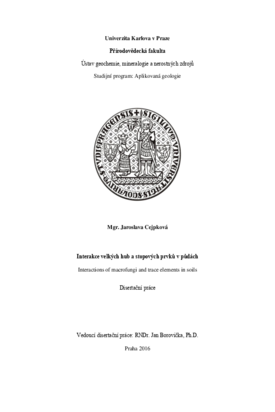Interakce velkých hub a stopových prvků v půdách
Interactions of macrofungi and trace elements in soils
dizertační práce (OBHÁJENO)

Zobrazit/
Trvalý odkaz
http://hdl.handle.net/20.500.11956/78573Identifikátory
SIS: 117338
Katalog UK: 990021109470106986
Kolekce
- Kvalifikační práce [21483]
Autor
Vedoucí práce
Oponent práce
Gabriel, Jiří
Drahota, Petr
Fakulta / součást
Přírodovědecká fakulta
Obor
-
Katedra / ústav / klinika
Ústav geochemie, mineralogie a nerostných zdrojů
Datum obhajoby
23. 5. 2016
Nakladatel
Univerzita Karlova, Přírodovědecká fakultaJazyk
Čeština
Známka
Prospěl/a
Klíčová slova (česky)
stopové prvky, makromycety, ektomykorhizy, těžké kovy, rhizosféraKlíčová slova (anglicky)
trace elements, macromycetes, ectomycorrhizae, heavy metals, rhizosphereTato disertační práce navazuje na mou diplomovou práci, ve které jsem se zaměřila především na problematiku obsahu a stanovení uranu v plodnicích velkých hub (výsledky byly publikovány, Příloha 1). Závěr práce, tedy že plodnice hub neakumulují uran, mě vedl k úvaze, že prvky jako uran mohou být akumulovány v ektomykorhizách, protože některé publikované práce naznačovaly významnou roli hub v environmentální geochemii uranu. Proto jsem se rozhodla na mou diplomovou práci navázat a zabývat se obsahem stopových prvků v ektomykorhizách obecně. Vzhledem k tomu, že jsem měla možnosti využít řadu analytických metod, podílela jsem se i na jiných studiích z oboru geomykologie. V reakci na poplašné zprávy šířící se v českých médiích jsem se zaměřila na obsah a distribuci radiocesia v plodnicích hřibu hnědého. Jak je patrné z Přílohy 2, plodnice hřibu hnědého v České republice nepředstavují pro konzumenty zdravotní riziko. Pomocí molekulárních metod (PCR se specifickými primery) jsme zkoumali distribuci mycelia saprotrofní houby pečárky Bernardovy v půdním profilu na lokalitě v Praze (Příloha 3). Naše výsledky ukázaly, že mycelium tohoto druhu zasahuje i do hloubky 30 cm a že izotopické složení olova v plodnicích tohoto druhu naznačuje transport tohoto kovu z hloubky minimálně okolo 13-17 cm. Hlavní část mé...
This PhD thesis follows my master's thesis, which I focused on the problem of uranium determination and content in macrofungal fruit-bodies (the results have been published, Appendix 1). Macrofungi apparently do not accumulate uranium in fruit-bodies but as other studies suggested major roles of fungi in environmental geochemistry of uranium, I hypothesized possible accumulation of uranium and other elements in ectomycorrhizae. I therefore decided to continue the research and focus on investigation of trace elements in ectomycorrhizae. As I had opportunity to use a variety of analytical methods, I also participated in other studies in the field geomycology and the results are included in this thesis. In response to alarmist reports in Czech media, I focused on activity and distribution of radiocaesium in fruit-bodies of Boletus badius. As demonstrated in Appendix 2, the fruit- bodies of this species do not represent a health risk for mushroom consumers. Distribution of mycelium of saprotrophic Agaricus bernardii in a soil profile in Prague was investigated by use of molecular methods (PCR with specific primers). The results have shown that the mycelium reaches the depth of 30 cm. Lead isotopic composition of fruit- bodies suggests lead can be accumulated from soil depth of 13-17 cm (Appendix 3)....
